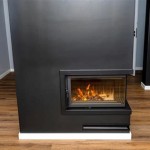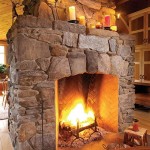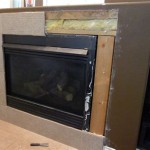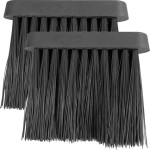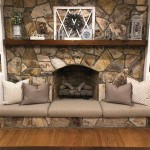Corner Fireplace Mantel Surround: Design, Installation, and Considerations
A corner fireplace mantel surround serves as both a functional and aesthetic focal point within a room. Optimizing space efficiency while enhancing visual appeal, it presents a unique design challenge and opportunity. This article explores various aspects of corner fireplace mantel surrounds, encompassing design considerations, material choices, installation techniques, and safety regulations.
Understanding the Advantages of a Corner Fireplace
Strategically positioning a fireplace in a corner presents distinct advantages, particularly in smaller living spaces. It maximizes usable wall area, allowing for more flexible furniture arrangement. Rather than consuming an entire wall, the fireplace occupies a less intrusive space, permitting the placement of entertainment centers, bookshelves, or large windows along other walls. Moreover, a corner fireplace can create a visual anchor, defining the room's layout and directing attention inward. This placement fosters a sense of warmth and intimacy, making it an ideal choice for rooms intended for relaxation and social gathering.
Furthermore, a corner fireplace may simplify venting logistics in certain home designs. Exterior walls often abut at a corner, facilitating efficient flue or exhaust pipe routing. This can reduce construction costs and minimize the visual impact of the chimney or vent on the exterior of the house. Effective utilization of space and streamlined venting contribute to the growing popularity of corner fireplace installations in both new construction and renovation projects.
Design Considerations for Corner Fireplace Mantel Surrounds
Designing a corner fireplace mantel surround requires careful consideration of room size, architectural style, and personal preferences. The mantel itself should be proportional to the fireplace and the room, avoiding an overly bulky appearance in smaller spaces or an insignificant presence in larger areas. The surround, encompassing the area around the firebox, needs to harmonize with the mantel and the surrounding wall finishes.
Style is a crucial element of the design process. A modern aesthetic might favor clean lines, minimalist detailing, and materials like concrete, steel, or glass. Traditional styles often incorporate intricate moldings, carved details, and rich wood finishes. Transitional designs blend elements of both modern and traditional styles, offering a versatile option that complements a wide range of interior decors. The choice of style should reflect the overall character of the home and the homeowner's taste.
The corner placement introduces unique geometric considerations. The mantel surround must seamlessly integrate with the angled walls, potentially requiring custom-cut materials and precise measurements. The angle of the corner may influence the shape of the mantel – a straight-edged mantel might appear awkward, while a curved or angled design can better conform to the room's geometry. Consideration must also be given to the visibility of the fireplace from different vantage points within the room. The design should ensure an unobstructed view of the fire and a balanced visual composition from all angles.
Integration with existing architectural features is also important. The mantel surround should complement elements such as crown molding, baseboards, and window trim. Selecting materials and finishes that echo or enhance these existing features creates a cohesive and harmonious design. Attention to detail, such as the placement of lighting fixtures and the inclusion of decorative elements, can further enhance the overall aesthetic appeal of the corner fireplace mantel surround.
Material Selection for Corner Fireplace Mantel Surrounds
The selection of materials for a corner fireplace mantel surround is driven by aesthetic considerations, durability requirements, and safety standards. Several materials are commonly used, each offering distinct advantages and disadvantages.
Wood is a classic choice, offering warmth, versatility, and a wide range of finishing options. Solid wood mantels and surrounds provide a timeless appeal and can be stained or painted to match any décor. However, wood is susceptible to heat damage and should be installed according to safety codes, maintaining adequate clearances from the firebox. Engineered wood products, such as MDF (Medium-Density Fiberboard), offer a more affordable and stable alternative to solid wood. MDF can be easily shaped and painted, but it lacks the natural grain and character of solid wood.
Stone, including natural stone like marble, granite, and limestone, as well as manufactured stone veneer, provides a durable and elegant option. Stone is heat-resistant and adds a sense of permanence and sophistication to the fireplace surround. Natural stone is often more expensive than other materials and requires professional installation. Manufactured stone veneer offers a more cost-effective alternative, replicating the look of natural stone while being lighter and easier to install.
Brick is another popular choice, particularly for traditional or rustic designs. Brick is fire-resistant, durable, and adds a textured element to the fireplace surround. It can be painted or left exposed to showcase its natural color and texture. Brick veneer offers a thinner and lighter alternative to full-thickness brick, making it suitable for applications where weight is a concern.
Metal, such as steel, stainless steel, and cast iron, can be used to create a modern or industrial look. Metal is heat-resistant and durable, and can be finished in a variety of colors and textures. Metal mantels and surrounds often feature clean lines and minimalist designs. However, metal can become hot to the touch and should be properly insulated to prevent burns.
When selecting materials, it is crucial to consider their fire resistance and compliance with local building codes. Fire-rated materials are essential for areas close to the firebox, while less heat-sensitive materials can be used for the mantel itself. Proper installation practices, including maintaining adequate clearances from combustible materials, are critical to ensuring the safety of the fireplace surround.
Installation Considerations and Safety Regulations
Installing a corner fireplace mantel surround requires careful planning, precise measurements, and adherence to safety regulations. Proper installation is crucial to ensure the structural integrity of the surround and the safe operation of the fireplace.
Before beginning the installation, it is essential to consult local building codes and obtain any necessary permits. These codes specify minimum clearances from combustible materials, required fire ratings for certain materials, and other safety standards. Failure to comply with these regulations can result in fines or the need to redo the installation.
The installation process typically begins with preparing the corner area. This may involve removing existing finishes, reinforcing the wall structure, and ensuring the fireplace is properly vented. Precise measurements are essential to ensure the mantel and surround fit snugly against the angled walls. Cutting materials to the correct angles can be challenging and may require specialized tools and techniques.
When installing the mantel, it is important to use appropriate fasteners and adhesives to ensure it is securely attached to the wall. The weight of the mantel should be evenly distributed, and the support structure should be strong enough to bear the load. For stone or brick mantels, professional installation is often recommended due to the weight and complexity of the materials.
Maintaining proper clearances from the firebox is critical to prevent heat damage to the mantel and surround. The specific clearance requirements vary depending on the type of fireplace and the materials used in the mantel and surround. Typically, a minimum clearance of 6 inches is required from the top of the firebox to the bottom of the mantel, and a minimum clearance of 12 inches is required from the sides of the firebox to the surrounding materials. These clearances can be reduced by using heat shields or non-combustible materials.
After the installation is complete, it is important to thoroughly inspect the mantel and surround to ensure they are securely attached and meet all safety requirements. A professional inspection may be advisable to verify compliance with building codes and ensure the safe operation of the fireplace. Regular maintenance, including cleaning the mantel and surround and inspecting for any signs of damage, is essential to prolong its lifespan and ensure continued safety.
Enhancing a Corner Fireplace with Decorative Elements
The addition of decorative elements significantly contributes to the overall aesthetic of a corner fireplace mantel surround. These elements can personalize the space, reflecting individual style and enhancing the visual appeal of the fireplace as a focal point. The choice of decorative items should complement the mantel's design and the room's existing décor.
Mirrors, strategically placed above the mantel, create an illusion of increased space and reflect light, enhancing the brightness of the room. A large, ornate mirror can add a touch of elegance and grandeur, while a smaller, simpler mirror can complement a minimalist design. The frame of the mirror should coordinate with the mantel's material and finish, creating a cohesive look.
Artwork, including paintings, prints, and sculptures, adds visual interest and personality to the mantel. The artwork should be proportional to the size of the mantel and the room. A large, bold painting can make a statement, while a collection of smaller pieces can create a more intimate and curated feel. The color palette of the artwork should complement the room's overall color scheme.
Decorative objects, such as vases, candle holders, and figurines, can be arranged on the mantel to add texture and visual interest. The objects should be of varying heights and sizes to create a dynamic composition. Grouping objects in odd numbers is often more visually appealing than even numbers. The materials and finishes of the objects should complement the mantel's design and the room's décor.
Greenery, including plants and flowers, adds a touch of nature to the fireplace mantel surround. A potted plant can soften the hard lines of the mantel and add a pop of color. Fresh flowers can bring a touch of elegance and fragrance to the room. Artificial plants offer a low-maintenance alternative to live plants, providing a similar aesthetic without the need for watering or pruning.
Personal items, such as family photos, souvenirs, and collectibles, add a personal touch to the mantel. These items reflect the homeowner's personality and create a sense of warmth and intimacy. The personal items should be arranged in a thoughtful and organized manner, avoiding clutter. Rotating the items periodically can keep the mantel looking fresh and interesting.

How To Make A Corner Fireplace Mantel Look Good 15 Examples

How To Decorate A Corner Fireplace Mantel For The Holidays Making It In Mountains

Auseo Electric Fireplace Mantel Wood Surround Firebox Freestanding Corner Heater Infrared Quartz Adjustable Led Flame Remote Control 750w 1501w White Com

Corner Fireplace Mantel

Working With A Corner Fireplace Emily Clark
Corner Fireplace Ideas

Auseo Electric Fireplace Mantel Wood Surround Firebox Freestanding Corner Adjustable Led Flame Remote Control Brown Com

How To Make A Corner Fireplace Mantel Look Good 15 Examples

Corner Fireplace Ideas Design

Modern Ember Lenwood Traditional Wood Fireplace Mantel Surround Kit Unfinished 48 Inch Opening Classic Design Tiered Frame Molding Surrounds Mantels

